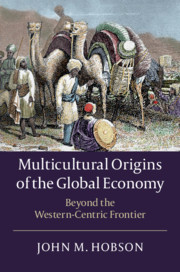Book contents
- Multicultural Origins of the Global Economy
- Multicultural Origins of the Global Economy
- Copyright page
- Dedication
- Contents
- Figures
- Tables
- Acknowledgements
- 1 Mapping a New Global Political Economy
- Part I Multicultural Origins of the First (Historical Capitalist) Global Economy, 1500–1850
- 2 Going Global 1.0
- 3 The Afro-Indian Pivot (I)
- 4 The Afro-Indian Pivot (II)
- 5 Entangled Indo-European Agencies
- 6 Indian Merchant-Financial Capitalists
- Part II What Was Global about the First Global Economy, 1500–c. 1850?
- Part III Empire and the First Global Economy in the Making of Modern Industrial Capitalism, 1500–1800
- Part IV The Second Great Divergence, 1600–1800: Differing ‘Developmental Architectures’ in Global Contexts
- Part V Rehabilitating and Provincialising Western Imperialism: Afro-Asians inside and outside the Shadow of Empire
- Book part
- Bibliography
- Index
4 - The Afro-Indian Pivot (II)
Entangled Agencies and the Power of Africans, Indians and West Asian Muslims
from Part I - Multicultural Origins of the First (Historical Capitalist) Global Economy, 1500–1850
Published online by Cambridge University Press: 17 December 2020
- Multicultural Origins of the Global Economy
- Multicultural Origins of the Global Economy
- Copyright page
- Dedication
- Contents
- Figures
- Tables
- Acknowledgements
- 1 Mapping a New Global Political Economy
- Part I Multicultural Origins of the First (Historical Capitalist) Global Economy, 1500–1850
- 2 Going Global 1.0
- 3 The Afro-Indian Pivot (I)
- 4 The Afro-Indian Pivot (II)
- 5 Entangled Indo-European Agencies
- 6 Indian Merchant-Financial Capitalists
- Part II What Was Global about the First Global Economy, 1500–c. 1850?
- Part III Empire and the First Global Economy in the Making of Modern Industrial Capitalism, 1500–1800
- Part IV The Second Great Divergence, 1600–1800: Differing ‘Developmental Architectures’ in Global Contexts
- Part V Rehabilitating and Provincialising Western Imperialism: Afro-Asians inside and outside the Shadow of Empire
- Book part
- Bibliography
- Index
Summary
Chapter 4 also focuses on the Afro-Indian pivot of the FGE by highlighting interconnections between African slavers, consumers/prosumers and Indian cotton textile trade/production in the making of the FGE. The first section brings the power and agency of African slavers to the fore, revealing how they were able to negotiate with the European slavers from a position of equality and often strength. The Africans had developed a vast infrastructure and knowledge pool in their dealings with the Muslims since the seventh century when the Islamic slave trade first emerged in Africa. Critically, the Africans preferred Indian cotton textiles (ICTs) to the Manchester ‘fustians’ right through to the latter part of the eighteenth century. This reflected the strength of Gujarati Indian merchants and the weakness of their British counterparts. The chapter also interrogates fundamentalist postcolonialism's ‘anti-racist refusal’ to recognise the power and agency of the African slavers. Finally, the chapter reveals the entangled agencies of the African slavers and prosumers along with the Gujarati Indian textile merchant capitalists. The latter formed symbiotic bonds with African middlemen (Vashambadzi and Patamares) which, inter alia, gave Indian merchants a considerable advantage over the Portuguese.
Keywords
- Type
- Chapter
- Information
- Multicultural Origins of the Global EconomyBeyond the Western-Centric Frontier, pp. 110 - 129Publisher: Cambridge University PressPrint publication year: 2020

